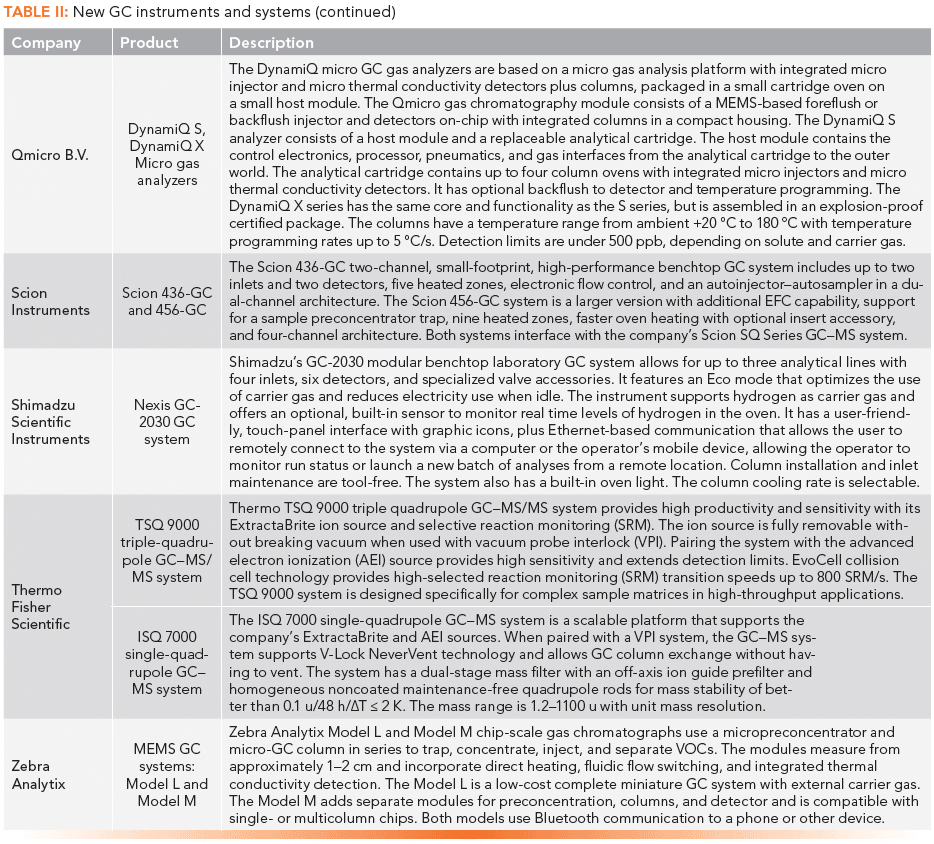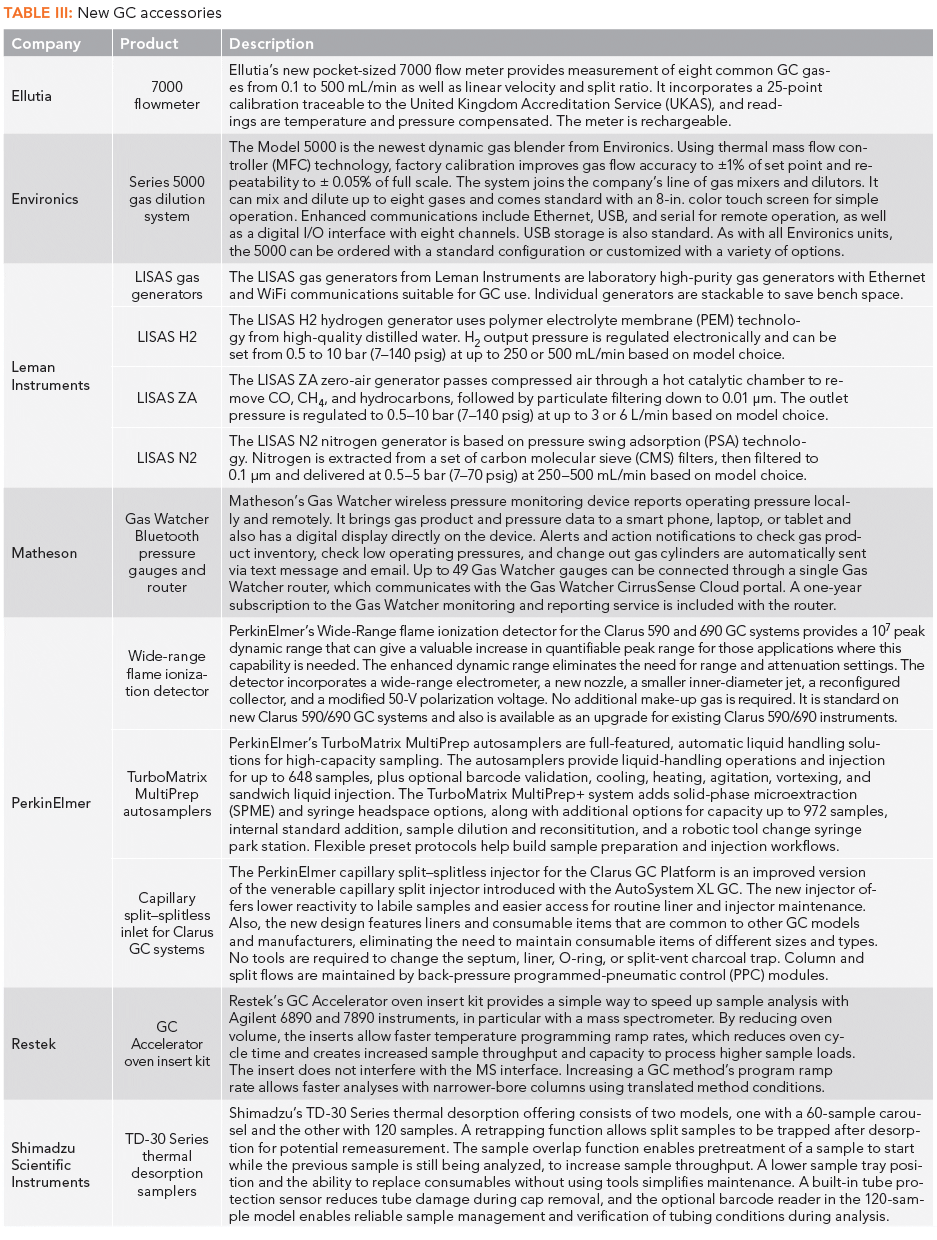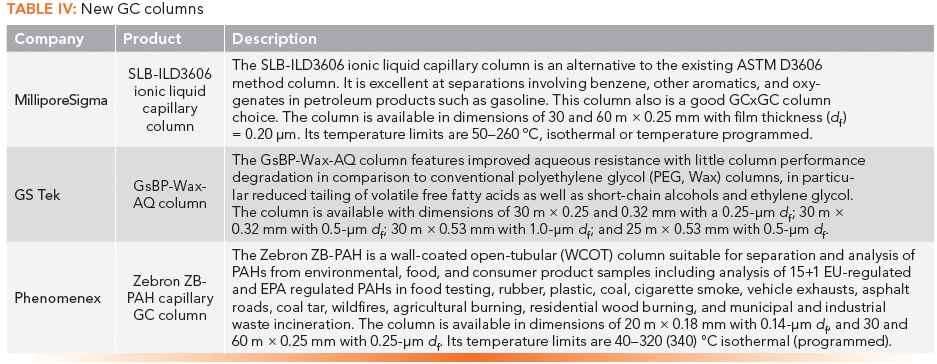New Gas Chromatography Products for 2017–2018
LCGC North America
We present our annual review of new developments in the field of gas chromatography, which this year includes eight new GC and GC–MS laboratory benchtop systems as well as numerous new columns and accessories.
The 69th session of the Pittsburgh Conference on Analytical Chemistry and Applied Spectroscopy (Pittcon) was held February 26–March 1, 2018, at the Orange County Convention Center in Orlando, Florida. Arguably old enough to be deemed venerable, Pittcon returned to Orlando one day shorter in length. This change produced a more concentrated experience for the approximately 11,415 attendees, 25% of whom came from outside the United States from 80 countries. The exposition consisted of 1247 booths for 713 exhibitors, 92 of which were first-timers. The technical program consisted of more than 2000 presentations for a total of 216 symposia, award, oral, contributed, and poster sessions. The well-known Pittcon Short Courses continued in popularity, with about 900 participants attending 93 offerings.
Notable among the award sessions were the LCGC Lifetime Achievement in Chromatography Award presented to Ronald Majors (ChromPrep), and the LCGC Emerging Leader in Chromatography Award presented to Zachary S. Breitbach (AbbVie).
Pittcon 2019 is set to return to Philadelphia next year, March 18–21, at the Pennsylvania Convention Center. The following year in 2020, the conference will complete another round trip back to Chicago.
This annual "GC Connections" installment reviews gas chromatography (GC) instrumentation, columns, and accessories shown at this year's Pittcon or introduced during the previous year. Table I shows a list of those companies that introduced new GC products since Pittcon 2017. For a review of new products in other areas of chromatography, columns, and related accessories, please see the "Column Watch" and "Perspectives in Modern HPLC" columns in the April 2018 issue of LCGC North America (1,2) as well as the "Sample Prep Perspectives" column in this issue (3).

The information presented here is based on manufacturers' replies to questionnaires, as well as on additional information from manufacturers' press releases, websites, and product literature about the past year's products, and not upon actual use or experience of the author. Every effort has been made to collect accurate information, but because of the preliminary nature of some of the material LCGC North America cannot be responsible for errors or omissions. This column installment cannot be considered to be a complete record of all new GC products introduced this year at Pittcon or elsewhere because not all manufacturers chose to respond to the questionnaire, nor is all of the submitted information necessarily included here because of the limited available space and the editors' judgment as to its suitability.
GC: 2017–2018
This past year in GC was yet again filled with new developments and improvements (Table II). There were no fewer than eight new GC and GC–mass spectrometry (MS) laboratory benchtop systems shown at the various analytical instrument shows during the year, including Analytica and FACSS for example, as well as Pittcon. LECO's Pegasus GC-HRT+ 4D system is the company's newest high-performance GC×GC system, coupled with a time-of-flight (TOF) MS detector that delivers incrementally higher resolution, sensitivity, and speed. Agilent Technologies introduced the 7250 GC quadrupole time-of-flight (QTOF) GC–MS system for full-spectrum, high-resolution, accurate-mass data with a wide dynamic range for identifying, quantifying, and investigating GC-amenable compounds. Thermo Fisher Scientific showed a pair of new GC–MS instruments, the ISQ 7000 single-quadrupole GC–MS system and the TSQ 9000 triple-quadrupole GC–MS/MS system, which share features such as vent-free column exchange and are intended for use in routine workhorse applications or with complex sample matrices in high-throughput applications.

A triplet of benchtop GC systems rounds out the laboratory instruments. From Shimadzu Scientific Instruments, the GC-2030 system is a modular gas chromatograph that allows for up to three analytical lines with four inlets, six detectors, and specialized valve accessories. PerkinElmer brought out the Clarus 690 GC system, the most recent in the Clarus family, with support for fast temperature programming and high throughput, along with an updated split–splitless inlet and wide-range flame ionization detection (FID) system. Scion instruments, with its roots in Varian, Chrompack, and Bruker, displayed the 436-GC two-channel small footprint high-performance benchtop GC system, and the 456-GC four-channel expanded version with additional flow control, heating, trapping, detection, and fast oven programming. All of these benchtop systems interface with their company's respective mass spectrometers.

I found it remarkable that the remaining new instruments fell into the portable micro-GC category, and that half of the six companies offering them were first-timers in this segment. Defiant Technologies has offered miniaturized portable GC systems for a while. The newest is the TOCAM Total Organic Chemical Air Monitor with dual photoionization detection (PID) systems, a sample concentrator, and a GC column for both total volatile organic compounds (VOCs) in air, as well as compound-specific analysis by GC. Apix Analytix showed the ChromPix2 modular multigas micro-GC analyzer, which incorporates up to four micro-GC modules with different analytical columns, detectors, and carrier-gas flows running simultaneously for refinery gas, natural gas, biomethane, indoor and outdoor air, VOCs, and BTEX. Zebra Analytix introduced the Model L and Model M chip-scale gas chromatographs with a micropreconcentrator and micro-GC column arranged in series to trap, concentrate, inject, and separate VOCs. Qmicro brought its DynamiQ micro-GC gas analyzers based on a micro gas analysis platform with integrated microinjector and micro thermal conductivity detectors plus columns. From Nanova Environmental, the P100 two-dimensional (2D) portable GC system includes an in-built VOC trapping unit, a helium carrier-gas supply, columns, photoionization detectors, and control. Finally, from Omniscient Tech, the Cloud-enabled OMNI-2000 VOC analyzer utilizes microelectromechanical systems (MEMS) preconcentration, columns, and detection for VOC measurement.

Of course, GC accessories (Table III) saw significant activity, including autosampling, GC-specific sample preparation, and columns as well. Shimadzu Scientific Instruments introduced the TD-30 series thermal desorption units with 60- and 120-sample capacities. Teledyne Tekmar showed the three-dimensional Atomx XYZ automated purge-and-trap VOC sample preparation system. PerkinElmer had the TurboMatrix MultiPrep automated liquid handling, solid-phase microextraction (SPME), and headspace autosamplers, plus a new Wide-Range FID system and a revamped split–splitless inlet for Clarus GC systems. The popularity of laboratory gas generators continued with the FID Tower detector gas generator from VICI, and the stackable LISAS hydrogen, zero-air, and nitrogen generators from Leman Instruments, which both reduce the footprint for multiple gas generation. Ellutia displayed the 7000 pocket-sized flow meter, and Matheson introduced a Bluetooth- and Cloud-enabled gas pressure gauge. Environics has updated its precision dynamic gas blending product line with the Model 5000 dynamic gas blender, which features enhanced communications and a color touch screen. Restek introduced a GC Accelerator oven insert kit that facilitates higher-speed separations with faster GC oven ramp rates.

New GC columns were harder to find (Table IV), but the offerings from Millipore Sigma, GS Tek, and Phenomenex bring enhanced separations to several application-specific areas, including polyaromatic hydrocarbons (PAHs), fatty acids, and ASTM petroleum methods.
I look forward to discovering another crop of new GC products in the coming year, especially in the active micro-GC arena. And I hope to enjoy Pittcon's Septuagennial Pt anniversary in Philadelphia in 2019. Although, 70Yb is a more appropriate anniversary element for this crowd.

Acknowledgments
I would like to thank the manufacturers and distributors that kindly furnished the requested information, which allowed a timely report on new product introductions over the past year. For those manufacturers who did not receive a "New Products" questionnaire this year and would like to receive one and be considered for early inclusion into the 2019 new GC and related product introductions review, as well as the other related review articles to be published in LCGC, please send the name of the primary company contact plus the mailing and e-mail addresses to Laura Bush, Editorial Director, LCGC and Spectroscopy, UBM Americas, 485 Rte. 1 South, Bldg. F, Suite 210, Iselin, NJ 08830, Attn: 2019 New Chromatography Products. The questionnaire will be sent out later in 2018.
References
(1) D.S. Bell, LCGC North Am. 35(4), 234–247 (2018).
(2) M.W. Dong, LCGC North Am. 35(4), 256–265 (2018).
(3) D.E. Raynie, LCGC North Am. 35(5), 294–303 (2018).
ABOUT THE COLUMN EDITOR
John V. Hinshaw "GC Connections" editor John V. Hinshaw is a Senior Scientist at Serveron Corporation in Beaverton, Oregon, and a member of LCGC's editorial advisory board. Direct correspondence about this column to the author via e-mail: LCGCedit@ubm.com

John V. Hinshaw

Fundamentals of Benchtop GC–MS Data Analysis and Terminology
April 5th 2025In this installment, we will review the fundamental terminology and data analysis principles in benchtop GC–MS. We will compare the three modes of analysis—full scan, extracted ion chromatograms, and selected ion monitoring—and see how each is used for quantitative and quantitative analysis.
From Gas to Gas: Fundamentals of Static Headspace Extraction-Gas Chromatography
August 9th 2024In this article, we discuss the fundamentals of headspace extraction, including static versus dynamic extraction, establishing equilibrium in the vial, consequences of the partition coefficient, temperature, pressure, and transfer to the gas chromatograph.

.png&w=3840&q=75)

.png&w=3840&q=75)



.png&w=3840&q=75)



.png&w=3840&q=75)






